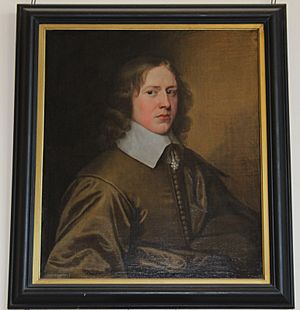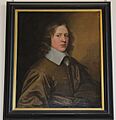Brian Fairfax facts for kids
Brian Fairfax (1633–1711) was an English politician and writer. He lived during a very exciting time in English history, when the country was going through big changes, including the return of the king after a period without one. Brian Fairfax was close to important people and played a small but interesting part in these events.
Contents
Early Life and Education
Brian Fairfax was born on October 6, 1633, in a town called Newton Kyme in Yorkshire, England. He was the second son of Henry Fairfax, who was a church leader.
Brian wrote about his early life for his sons. He went to school in Coxwold, Yorkshire, for four years. After that, he went to Trinity College, Cambridge, which is a famous university. He earned his first degree in 1651 and a master's degree in 1655.
Working for Important People
In 1658, Brian traveled to France with the Earl of Kildare. When he came back, he was at the wedding of his cousin, Mary Fairfax, to the Duke of Buckingham.
The Duke of Buckingham was later sent to the Tower of London by Oliver Cromwell, who was then leading England. Brian went with his other cousin, Lord Fairfax, to ask for the Duke's release. Brian was often with Lord Fairfax during his later years and was there when he died.
Important Missions
In late 1659, Lord Fairfax sent Brian on an important secret trip to General Monck, who was in Scotland. Brian wrote about this journey and his meeting with the general in a story called Iter Boreale.
When he returned, Lord Fairfax was gathering gentlemen in Yorkshire to support a cause. Brian helped organize them. On January 6, 1660, Brian went to London to explain to the Speaker of the House of Commons why people in the north were gathering.
Soon after, Parliament sent a group, including Lord Fairfax, to the Hague to invite Charles II to return as king. Brian went along as Lord Fairfax's private secretary.
Serving the King
Later, Brian also went on two official trips to other countries with the Duke of Buckingham. He worked for the Duke for a while, but then decided it was safer to stop.
On January 21, 1670, Brian was given a job as an equerry to King Charles II. An equerry is someone who helps with the king's horses and travels with him. He kept this job until the king died.
After Charles II died, Brian did not take part in politics under the new king, James II. In 1688, he went to Holland with his young son, Brian, to visit Princess Mary. She was the godchild of his cousin, the Duchess of Buckingham. Princess Mary welcomed him warmly. When William III became king, Brian was made one of his equerries. He was 56 years old then, and the job was hard work. After three years, he became secretary to Archbishop Tillotson.
Later Life and Writings
When Archbishop Tillotson died in 1694, Brian Fairfax retired. He moved to York and spent his time writing and helping younger members of his family. He wrote letters to many famous writers of his time.
Brian wrote a book about the Duke of Buckingham. He also translated a book about a French Huguenot leader named Philip Mornay. He wrote several poems, with the most famous one being The Vocal Oak, which was about trees being cut down at Nun Appleton. In 1699, he also helped publish a book of memories written by his cousin, Lord Fairfax.
Family Life
Brian Fairfax passed away on September 20, 1711. He had married Charlotte Cary in Westminster Abbey on April 22, 1675. She died on November 14, 1709.
They had three sons: Brian, Ferdinando, and Charles. All three went to Westminster School.
- Brian Fairfax the younger was born on April 11, 1676. He also went to Trinity College, Cambridge. He became a commissioner of customs from 1723 until he died on January 9, 1749. He collected a very valuable library of books and a gallery of paintings at his home.
- Ferdinando also went to Trinity College, Cambridge.
- Charles went to Christ Church, Oxford. He became a church leader in Ireland and was known for being good at old Irish writing. He died on July 27, 1723.
Images for kids



